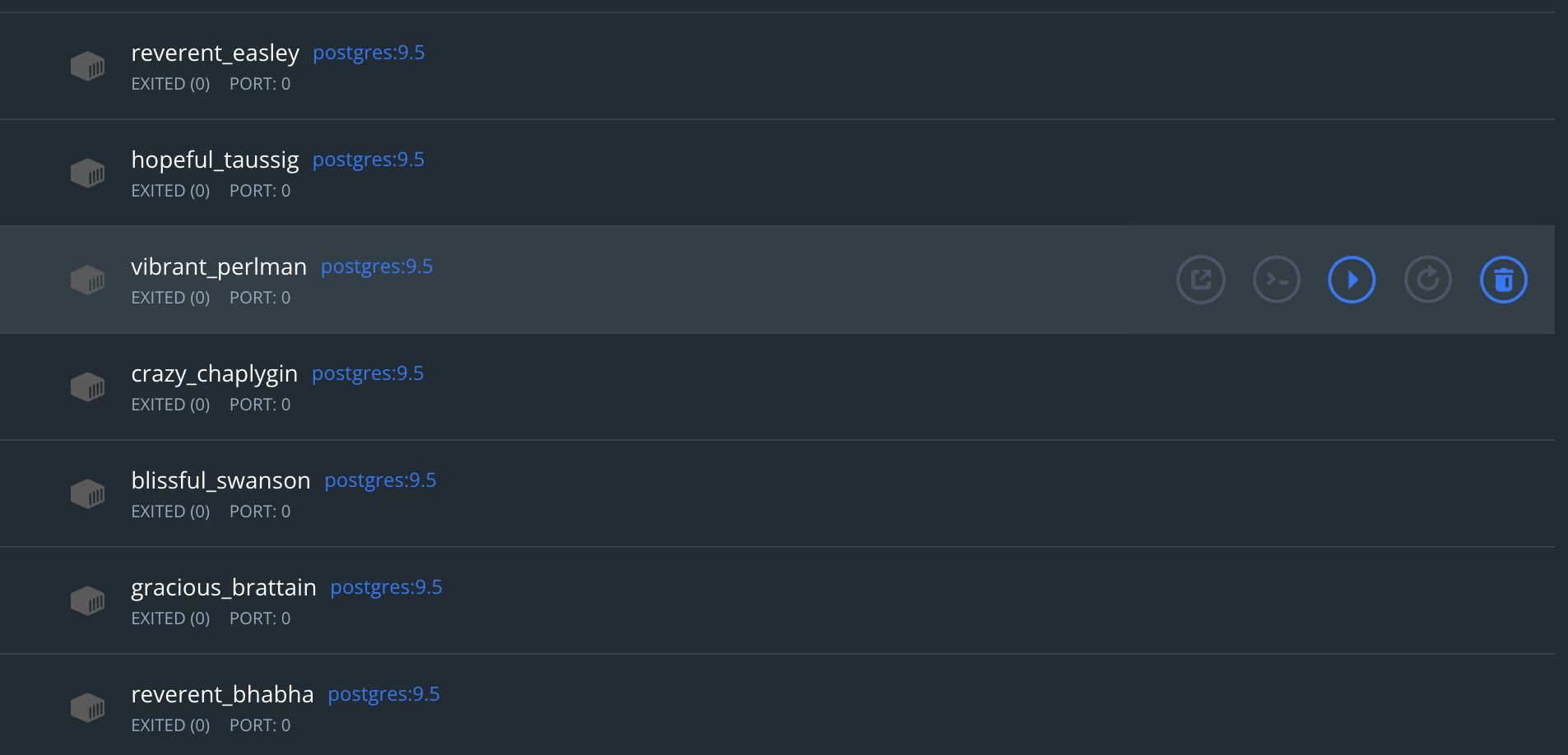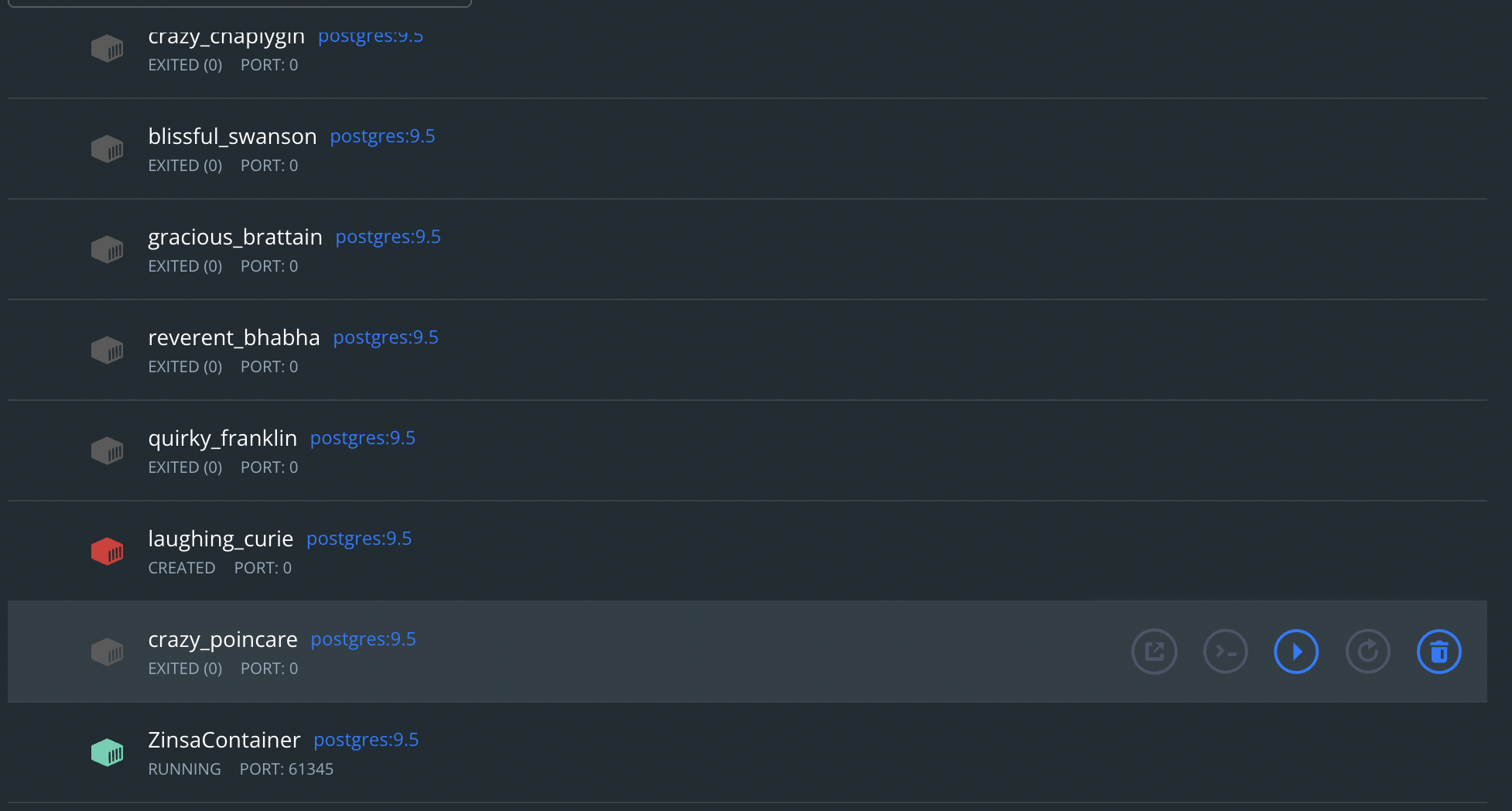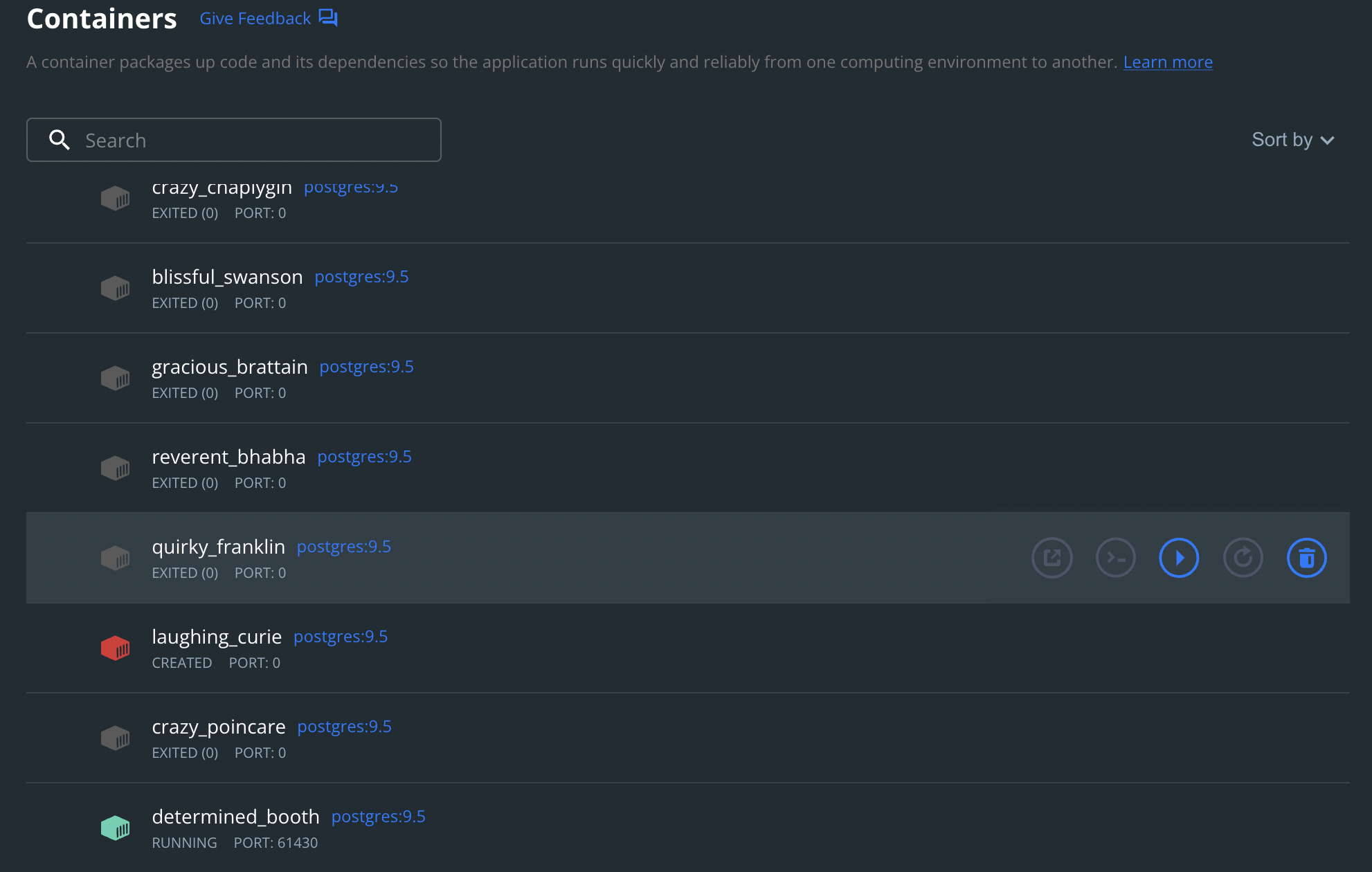TestPostGresContainer Python 컨테이너 이름 바꾸기
사이드 프로젝트중..
진귀한 장면을 발견했다.
컨테이너 이름이 무작위로 막 생성되어있었다.
사실 몇개는 이미 컨테이너가 띄워진 상태로 돌아가고 있어서 다 꺼버렸다.
원인을 찾던중..
도커로 Postgres를 띄우는 코드는 사이드프로젝트 통합테스트 코드밖에 없다고 생각하여 코드를 뜯어봤다.
오픈소스로 제공하는 testcontainers.postgres를 Python언어로 사용하고 있었는데, 분명 이 속에서 Docker Container의 이름을 지정하는 곳이 있을거라 생각했다.
1
2
3
4
5
6
7
8
9
10
class PostgresTestContainer(PostgresContainer):
def get_connection_url(self):
# windows docker connection
return super().get_connection_url().replace('localnpipe', 'localhost')
@pytest.fixture(scope="session", autouse=True)
def db_container(session_mocker):
with PostgresTestContainer(image="postgres:9.5", port=5432) as postgres:
...
PostgresTestContainer클래스는 PostgresContainer를 상속받고 있길래 PostgresContainer요 코드로 들어가봤다.
1
2
3
4
5
6
7
8
9
10
11
12
13
14
15
16
17
18
19
20
21
22
23
24
25
26
27
28
29
30
31
32
33
34
35
36
37
38
39
40
41
42
43
44
45
46
47
48
49
50
51
52
53
54
55
56
57
58
59
60
61
62
63
#
# Licensed under the Apache License, Version 2.0 (the "License"); you may
# not use this file except in compliance with the License. You may obtain
# a copy of the License at
#
# http://www.apache.org/licenses/LICENSE-2.0
#
# Unless required by applicable law or agreed to in writing, software
# distributed under the License is distributed on an "AS IS" BASIS, WITHOUT
# WARRANTIES OR CONDITIONS OF ANY KIND, either express or implied. See the
# License for the specific language governing permissions and limitations
# under the License.
import os
from testcontainers.core.generic import DbContainer
class PostgresContainer(DbContainer):
"""
Postgres database container.
Example
-------
The example spins up a Postgres database and connects to it using the :code:`psycopg` driver.
::
with PostgresContainer("postgres:9.5") as postgres:
e = sqlalchemy.create_engine(postgres.get_connection_url())
result = e.execute("select version()")
"""
POSTGRES_USER = os.environ.get("POSTGRES_USER", "test")
POSTGRES_PASSWORD = os.environ.get("POSTGRES_PASSWORD", "test")
POSTGRES_DB = os.environ.get("POSTGRES_DB", "test")
def __init__(self,
image="postgres:latest",
port=5432, user=None,
password=None,
dbname=None,
driver="psycopg2",
**kwargs):
super(PostgresContainer, self).__init__(image=image, **kwargs)
self.POSTGRES_USER = user or self.POSTGRES_USER
self.POSTGRES_PASSWORD = password or self.POSTGRES_PASSWORD
self.POSTGRES_DB = dbname or self.POSTGRES_DB
self.port_to_expose = port
self.driver = driver
self.with_exposed_ports(self.port_to_expose)
def _configure(self):
self.with_env("POSTGRES_USER", self.POSTGRES_USER)
self.with_env("POSTGRES_PASSWORD", self.POSTGRES_PASSWORD)
self.with_env("POSTGRES_DB", self.POSTGRES_DB)
def get_connection_url(self, host=None):
return super()._create_connection_url(dialect="postgresql+{}".format(self.driver),
username=self.POSTGRES_USER,
password=self.POSTGRES_PASSWORD,
db_name=self.POSTGRES_DB,
host=host,
port=self.port_to_expose)
이 클래스는 DbContainer를 상속받고 있고, 컨테이너 이름을 설정하지는 않는것 같다. 부모 클래스로 들어가봐야겠다.
1
2
3
4
5
6
7
8
9
10
11
12
13
14
15
16
17
18
19
20
21
22
23
24
25
26
27
28
29
30
31
32
33
34
35
36
37
38
39
40
41
42
43
44
45
46
47
48
49
50
51
52
53
54
55
56
57
58
59
60
61
62
63
64
65
66
#
# Licensed under the Apache License, Version 2.0 (the "License"); you may
# not use this file except in compliance with the License. You may obtain
# a copy of the License at
#
# http://www.apache.org/licenses/LICENSE-2.0
#
# Unless required by applicable law or agreed to in writing, software
# distributed under the License is distributed on an "AS IS" BASIS, WITHOUT
# WARRANTIES OR CONDITIONS OF ANY KIND, either express or implied. See the
# License for the specific language governing permissions and limitations
# under the License.
from testcontainers.core.container import DockerContainer
from testcontainers.core.waiting_utils import wait_container_is_ready
from deprecation import deprecated
ADDITIONAL_TRANSIENT_ERRORS = []
try:
from sqlalchemy.exc import DBAPIError
ADDITIONAL_TRANSIENT_ERRORS.append(DBAPIError)
except ImportError:
pass
class DbContainer(DockerContainer):
def __init__(self, image, **kwargs):
super(DbContainer, self).__init__(image, **kwargs)
@wait_container_is_ready(*ADDITIONAL_TRANSIENT_ERRORS)
def _connect(self):
import sqlalchemy
engine = sqlalchemy.create_engine(self.get_connection_url())
engine.connect()
def get_connection_url(self):
raise NotImplementedError
def _create_connection_url(self, dialect, username, password,
host=None, port=None, db_name=None):
if self._container is None:
raise RuntimeError("container has not been started")
if not host:
host = self.get_container_host_ip()
port = self.get_exposed_port(port)
url = "{dialect}://{username}:{password}@{host}:{port}".format(
dialect=dialect, username=username, password=password, host=host, port=port
)
if db_name:
url += '/' + db_name
return url
def start(self):
self._configure()
super().start()
self._connect()
return self
def _configure(self):
raise NotImplementedError
class GenericContainer(DockerContainer):
@deprecated(details="Use `DockerContainer`.")
def __init__(self, image):
super(GenericContainer, self).__init__(image)
이 클래스도 컨테이너의 이름을 설정하지는 않는다. DockerContainer를 상속받으므로 저 코드로 또 들어가봐야겠다.
1
2
3
4
5
6
7
8
9
10
11
12
13
14
15
16
17
18
19
20
21
22
23
24
25
26
27
28
29
30
31
32
33
34
35
36
37
38
39
40
41
42
43
44
45
46
47
48
49
50
51
52
53
54
55
56
57
58
59
60
61
62
63
64
65
66
67
68
69
70
71
72
73
74
75
76
77
78
79
80
81
82
83
84
85
86
87
88
89
90
91
92
93
94
95
96
97
98
99
100
101
102
103
104
105
106
107
108
109
110
111
112
113
114
115
116
117
118
119
120
121
122
123
124
125
126
127
128
129
130
131
132
133
134
135
136
137
138
139
140
141
142
143
144
from deprecation import deprecated
from docker.models.containers import Container
from testcontainers.core.docker_client import DockerClient
from testcontainers.core.exceptions import ContainerStartException
from testcontainers.core.utils import setup_logger, inside_container, is_arm
logger = setup_logger(__name__)
class DockerContainer(object):
def __init__(self, image, docker_client_kw: dict = None, **kwargs):
self.env = {}
self.ports = {}
self.volumes = {}
self.image = image
self._docker = DockerClient(**(docker_client_kw or {}))
self._container = None
self._command = None
self._name = None
self._kwargs = kwargs
def with_env(self, key: str, value: str) -> 'DockerContainer':
self.env[key] = value
return self
def with_bind_ports(self, container: int,
host: int = None) -> 'DockerContainer':
self.ports[container] = host
return self
def with_exposed_ports(self, *ports) -> 'DockerContainer':
for port in list(ports):
self.ports[port] = None
return self
@deprecated(details='Use `with_kwargs`.')
def with_kargs(self, **kargs) -> 'DockerContainer':
return self.with_kwargs(**kargs)
def with_kwargs(self, **kwargs) -> 'DockerContainer':
self._kwargs = kwargs
return self
def maybe_emulate_amd64(self) -> 'DockerContainer':
if is_arm():
return self.with_kwargs(platform='linux/amd64')
return self
def start(self):
logger.info("Pulling image %s", self.image)
docker_client = self.get_docker_client()
self._container = docker_client.run(self.image,
command=self._command,
detach=True,
environment=self.env,
ports=self.ports,
name=self._name,
volumes=self.volumes,
**self._kwargs
)
logger.info("Container started: %s", self._container.short_id)
return self
def stop(self, force=True, delete_volume=True):
self.get_wrapped_container().remove(force=force, v=delete_volume)
def __enter__(self):
return self.start()
def __exit__(self, exc_type, exc_val, exc_tb):
self.stop()
def __del__(self):
"""
Try to remove the container in all circumstances
"""
if self._container is not None:
try:
self.stop()
except: # noqa: E722
pass
def get_container_host_ip(self) -> str:
# infer from docker host
host = self.get_docker_client().host()
if not host:
return "localhost"
# check testcontainers itself runs inside docker container
if inside_container():
# If newly spawned container's gateway IP address from the docker
# "bridge" network is equal to detected host address, we should use
# container IP address, otherwise fall back to detected host
# address. Even it's inside container, we need to double check,
# because docker host might be set to docker:dind, usually in CI/CD environment
gateway_ip = self.get_docker_client().gateway_ip(self._container.id)
if gateway_ip == host:
return self.get_docker_client().bridge_ip(self._container.id)
return gateway_ip
return host
def get_exposed_port(self, port) -> str:
mapped_port = self.get_docker_client().port(self._container.id, port)
if inside_container():
gateway_ip = self.get_docker_client().gateway_ip(self._container.id)
host = self.get_docker_client().host()
if gateway_ip == host:
return port
return mapped_port
def with_command(self, command: str) -> 'DockerContainer':
self._command = command
return self
def with_name(self, name: str) -> 'DockerContainer':
self._name = name
return self
def with_volume_mapping(self, host: str, container: str,
mode: str = 'ro') -> 'DockerContainer':
# '/home/user1/': {'bind': '/mnt/vol2', 'mode': 'rw'}
mapping = {'bind': container, 'mode': mode}
self.volumes[host] = mapping
return self
def get_wrapped_container(self) -> Container:
return self._container
def get_docker_client(self) -> DockerClient:
return self._docker
def get_logs(self):
if not self._container:
raise ContainerStartException("Container should be started before")
return self._container.logs(stderr=False), self._container.logs(stdout=False)
def exec(self, command):
if not self._container:
raise ContainerStartException("Container should be started before")
return self.get_wrapped_container().exec_run(command)
여기서 보아하니 이름을 설정하는 곳을 찾은것 같다 __init__에서 초기화 작업을 해주고 있다.
확장성을 고려하여 None도 받아야한다. None을 받으면 컨테이너 이름을 랜덤으로 만들어서 띄우는데 이게 쌓이다보니 맨 위의 스크린샷이 된다.
그래서
1
2
3
4
5
class DockerContainer(object):
def __init__(self, image, name = None, docker_client_kw: dict = None, **kwargs):
...
self._name = name
처럼 name=None을 추가하고 self._name = name구문으로 초기화해주었다.
그리고 다시 통합테스트 코드로 가서
1
2
3
4
5
6
7
8
9
10
class PostgresTestContainer(PostgresContainer):
def get_connection_url(self):
# windows docker connection
return super().get_connection_url().replace('localnpipe', 'localhost')
@pytest.fixture(scope="session", autouse=True)
def db_container(session_mocker):
with PostgresTestContainer(image="postgres:9.5", port=5432, name="ZinsaContainer") as postgres:
...
name을 추가하여 통합테스트를 실행해보았다.
성공했다.
혹시몰라 인자에서 name을 빼보고 실행해보았다.
랜덤한 이름으로 컨테이너를 잘 띄운다.
후기
이걸 OCP라고하면 OCP일까? 기능을 확장시켰고 기존 요건인 None도 받을 수 있게 하였으니..
다만 걱정스러운건 이 소스를 제공한 사람들이 일부러 name을 인자로 받지 못하게 설계한것이 아닐까? 충돌의 위험이 있을까?
잘 모르겠다. 컨테이너가 계속 쌓이는것이 불편해서 하나의 이름을 가진 컨테이너로 띄웠다 내렸다 하고 싶은 마음에 시도해보았다.
앞으로 부딪히다보면 이 방법의 단점을 알 수도 있을 것 같다.
팀원들아 프로젝트 진행좀 해줘


